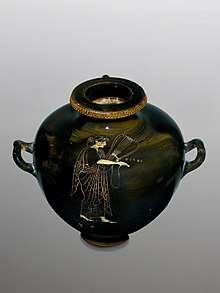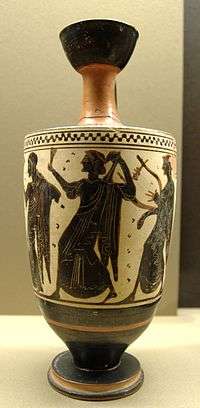Sappho Painter

Kalpis (pottery), Sappho Painter, ca. 510 BC, National Museum, Warsaw
Sappho Painter was an Attic black-figure vase painter, active c. 510–490 BCE.[1]
His name vase is a kalpis depicting the poet Sappho, currently held by the National Museum, Warsaw (Inv. 142333). The hand of the Sappho Painter has been identified on 95 vessels, 70% of which are lekythoi. His work has been also seen on tomb wall slabs and epinetra.[1]
Nearly half of his paintings are of the white-ground style. He apparently avoided the then-predominant red-figure technique, but sometimes used Six's technique whereby figures are laid on a black surface in white or red and details are incised so that the black shows through.[1] He was influenced and possibly trained by the Edinburgh Painter.[2]
References
External links

- The Sappho Painter's name vase at The Beazley Archive, University of Oxford
This article is issued from
Wikipedia.
The text is licensed under Creative Commons - Attribution - Sharealike.
Additional terms may apply for the media files.
